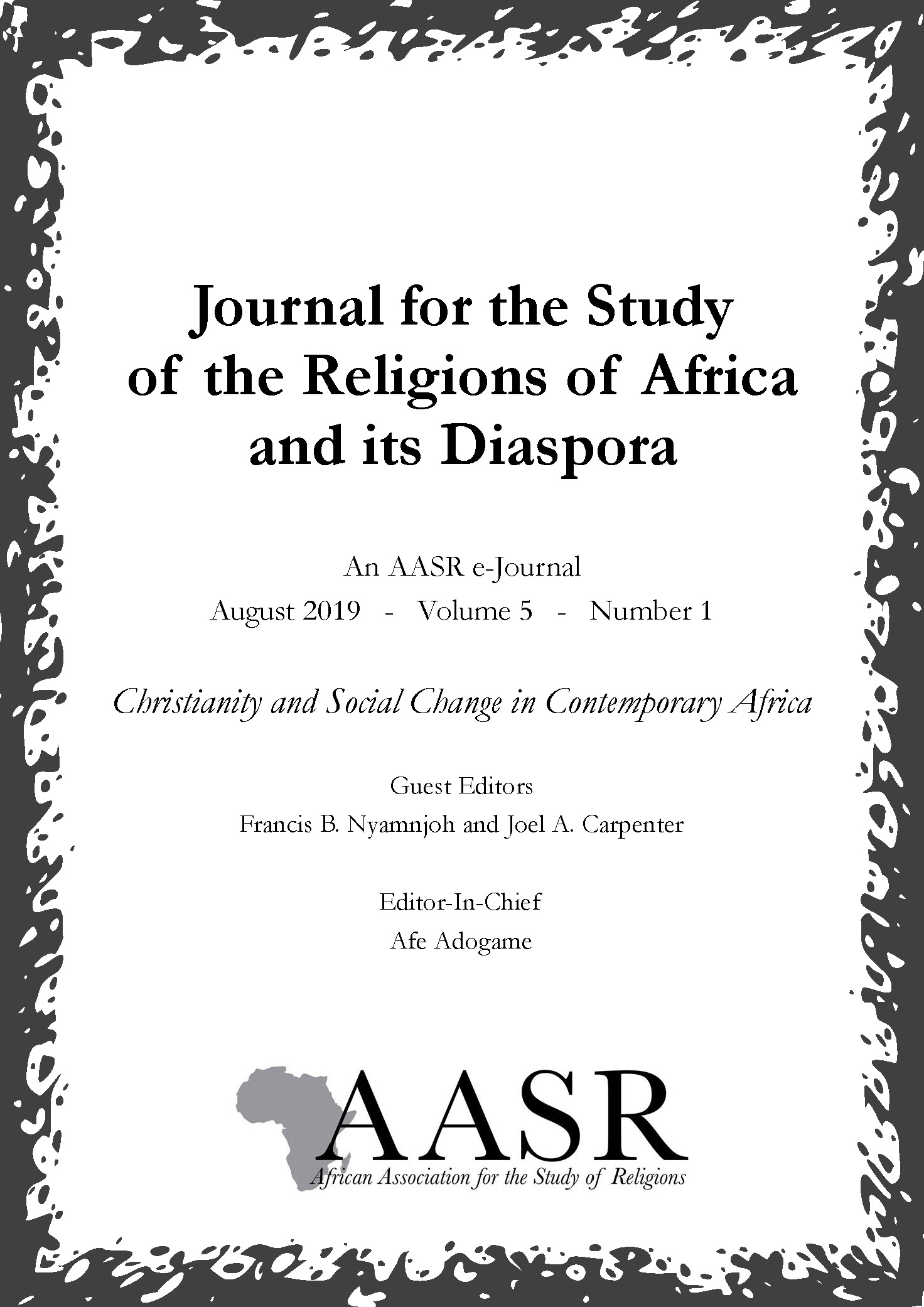Religious Collaboration Enhances Patient Satisfaction among Faith-Based Groups and Health Facilities in Western Kenya
Main Article Content
Keywords
HIV, Faith Based Health Facilities, Collaboration, Patient Satisfaction
Abstract
HIV and AIDS continue to be a major challenge in Kenya, especially in the Western region where, coincidentally, public and private health facilities are sparse, but with a relatively high number of faith based health facilities. This study seeks to examine whether and how collaboration among faith-based groups and health facilities in the provision of HIV prevention and treatment services for women ages 15-49 years is associated with high patient satisfaction. Using an embedded multiple-case study design, we purposively selected seven faith-based health facilities in Kakamega County. We conducted 33 in-depth interviews with HIV-positive individuals, 14 key informant interviews with health providers; and 8 focus group discussions with members of the community in the health facility catchment area. The findings indicated that, when health facilities demonstrated collaboration, there was a positive impact on patient satisfaction. Specifically, collaborations between faith-based organisations resulted in the improvement of HIV services.
Article Metrics Graph
References
African Mission Healthcare Foundation. (2015).'Kenya.'amhf.us/pages/countries/kenya. Accessed November 30, 2015.
Aluku, N.M. (2015). 'Cultural and religious influence on women's sexual and reproductive health in Kakamega county, Kenya'. Ph.D. diss., Catholic University of East Africa. 18.
Andersen, R.M. (1995). 'Revisiting the behavioral model and access to medical care: does it matter?' Journal of Health and Social Behavior, 36:1: 1-10. https://doi.org/10.2307/2137284
Berman, P. (2001). 'Getting more from private health care in poor countries: A missed opportunity'. International Journal of Quality in Health Care, 13:4: 279-280. https://doi.org/10.1093/intqhc/13.4.279
Browning, Melissa. (2014). Risky Marriage: HIV and Intimate Relationships in Tanzania. Lanham, MD: Lexington Books.
Campbell, C., Scott, K., Nhamo, M., Nyamukapa, C., Madanhire, C., Skovdal, M., Sherr, L., Gregson, S. (2013). 'Social capital and HIV Competent Communities: The role of community groups in managing HIV/AIDS in rural Zimbabwe.' AIDS Care 25 (Suppl. 1): S114-S122.https://doi.org/10.1080/09540121.2012.748170
Cohn, J., Von Schoen-Angerer, T., Jambert, E., Arreghini, G., and Childs, M. (2013). 'When falsified medicines enter the supply chain: Description of an incident in Kenya and lessons learned for rapid response'. Journal of Public Health Policy, 34:1: 22-30.https://doi.org/10.1057/jphp.2012.53
Dolan, K.A., Bijl, M. and White, B. (2004). 'HIV education in a Siberian Prison Colony for drug dependent males'. International Journal for Equity in Health0 3:1: 7. https://doi.org/10.1186/1475-9276-3-7
Dussault, G., and Franceschini, M. C. (2006). 'Not enough there, too many here: understanding geographical imbalances in the distribution of the health workforce'. Human Resources for Health 4:1: 12. https://doi.org/10.1186/1478-4491-4-12
Gordon, J.G. (2008). 'A critique of the financial requirements to fight HIV/AIDS'. The Lancet 372: no. 9635: 333-336.https://doi.org/10.1016/S0140-6736(08)61117-4
Hafner, C. (2009). 'Strengthening the Role of Faith-Based Organizations in Human Resources for Health Initiatives'. Capacity Project Knowledge Sharing, Legacy Series No. 8. http://www.capacityproject.org/images/stories/files/ legacyseries_8.pdf. Accessed January 18, 2013.
Kenya Demographic Health Survey. Rockville, MD: The Demographic Health Survey Program, 2014.
Kenya National Commission on Human Rights. (2012). Realizing sexual and reproductive health rights in Kenya: A myth or a reality? A report of the public inquiry into violations of sexual and reproductive health rights in Kenya. Nairobi: KNCHR.
Kimani, V.N. (2004). 'Human sexuality: meaning and purpose in selected communities in contemporary Kenya'. The Ecumenical Review 56:4 (October 2004): 404-421. https://doi.org/10.1111/j.1758-6623.2004.tb00527.x
Kranzer, K., and Ford, N. (2011). 'Unstructured treatment interruption of antiretroviral therapy in clinical practice: A systematic review'. Tropical Medicine and International Health 16:10: 1297-1313. https://doi.org/10.1111/j.1365-3156.2011.02828.x
Krishna, A. and Shrader, E. (2000). Cross-cultural measures of social capital: A tool and results from India and Panama. Washington, DC: World Bank.
Levy, J.M. (2009). 'Women's expectations of treatment and care after an antenatal HIV diagnosis in Lilongwe, Malawi'. Reproductive Health Matters 17:33: 152-161. https://doi.org/10.1016/S0968-8080(09)33436-9
Maman, S., Cathcart, R., Burkhardt, G., Omba, S., Behets, F. (2009). 'The role of religion in HIV-positive women's disclosure experiences and coping strategies in Kinshasa, Democratic Republic of Congo'. Social Science and Medicine 68: 965-70.https://doi.org/10.1016/j.socscimed.2008.12.028
Mombe, P.A., Orabator, A.E., Vella, D. (2012). AIDS 30 years down the line: Faith-based reflections about the epidemic in Africa. Nairobi: Paulines Publications Africa.
Muga, R., Kizito, P., Mbayah, M., Gakuruh, T. (2005). 'Chapter Two: Overview of the health system in Kenya'. In Kenya Demographic and Health Surveys 2005. Calverton, MD: ICR
Macro 2005. National AIDS Control Council (NACC). (2014). 'Kenya HIV County Profiles'. http://www.nacc.or.ke/images/documents/KenyaCountyProfiles.pdf. Accessed on November 30, 2015.
Ndiaye, C., Boileau, C., Zunzunegui, M.V., Koala, S., Aboubacrine, S.A., Niamba, P., Nguyen, V.K., Rashed, S. (2009). 'Gender-related factors influencing HIV serostatus disclosure in patients receiving HAART in West Africa'. World Health and Population 10: 24-35.https://doi.org/10.12927/whp.2009.20399
Olivier. J., Wodon, Q. (2010). 'Faith-inspired health services in Africa: Improving data collection for policy making: Africa Christian Health Associations'.Update 14:1: 11.
Phiri, Isabel Apawo, Beverly Haddad and Madipoane Masenya, editors. (2003). African Women, HIV/AIDS and Faith Communities. Pietermaritzburg, Cluster Publications.
Story, W. T., Taleb, F., Ahasan, S. M. M., and Ali, N. A. (2015). 'Validating the measurement of social capital in Bangladesh: A cognitive approach'. Qualitative Health Research 25:6: 806- 819. https://doi.org/10.1177/1049732315580106
Tran, B.X., Nguyen, N.P.T. (2012). 'Patient satisfaction with HIV/AIDS care and treatment in the decentralization of services delivery in Vietnam'. PLoS ONE 7:10:e46680. https://doi.org/10.1371/journal.pone.0046680
Trinitapoli, J. and Weinreb, A. (2012). Religion and AIDS in Africa. Oxford University Press. https://doi.org/10.1093/acprof:oso/9780195335941.001.0001
Wamai, R.G. (2009). 'The Kenya health system-Analysis of the situation and enduring challenges'. Japan Medical Association Journal, 52:2: 134-140.
Williams, M.V., Palar, K., Derose, K.P. (2011). 'Congregation-based programs to address HIV/AIDS: Elements of successful implementation.' Journal of Urban Health 88:3: 517-532. https://doi.org/10.1007/s11524-010-9526-5
Yin, R.K. (2009). Case Study Research: Design and Methods. Thousand Oaks, CA: Sage.
Zou, J., Yamanaka, Y., John, M., Watt, M., Ostermann, J., Thielman, N. (2009). 'Religion and HIV in Tanzania: Influence of religious beliefs on HIV stigma, disclosure, and treatment attitudes'. BMC Public Health 9: 75. https://doi.org/10.1186/1471-2458-9-75


